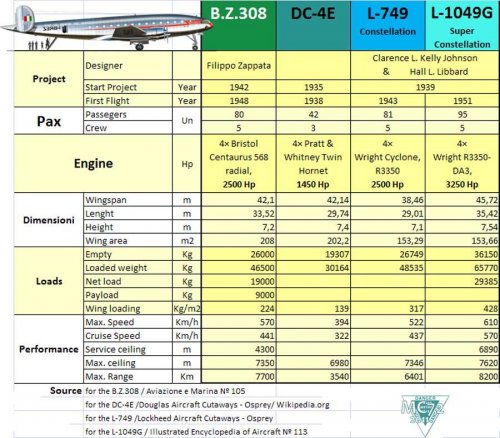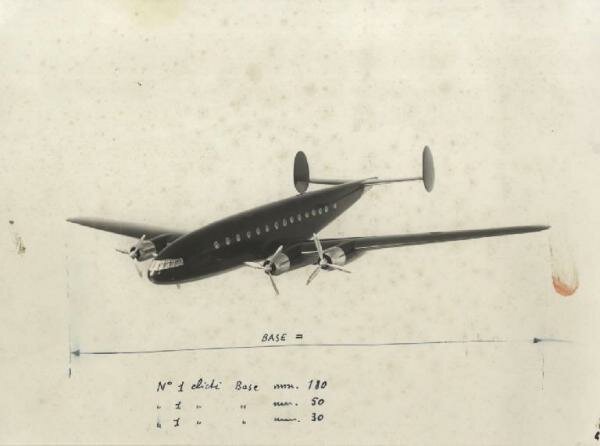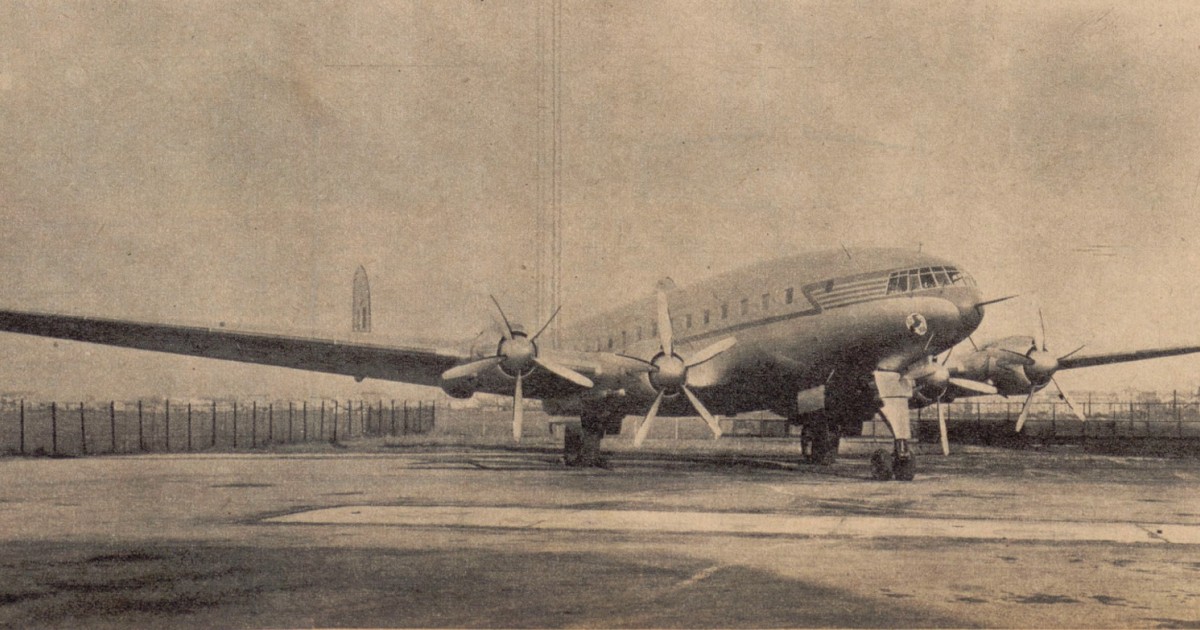You are using an out of date browser. It may not display this or other websites correctly.
You should upgrade or use an alternative browser.
You should upgrade or use an alternative browser.
Breda-Zappata BZ.308bis and BZ.408
- Thread starter hesham
- Start date
- Joined
- 14 June 2006
- Messages
- 2,300
- Reaction score
- 561
Sure... but nothing survived. The 408 could well be reconstructed using the Cant Z-511 as a reference.
Actualy the 308bis was a marketing ruse: Breda and Zappata hadn't the least expertise on pressurization (in Italy only Piaggio had) and the fuselage would have had to be totally redesigned. Breda spoke of a pressurized version because SIAI started talking and distributing arts of the SM-95S (first serious pressurized design by Marchetti was the SM-132, when British and French companies were contracted for the pressurization system). The last flying project of Zappata's, the AZ-8L from 1957, wasn't pressurized still...
Actualy the 308bis was a marketing ruse: Breda and Zappata hadn't the least expertise on pressurization (in Italy only Piaggio had) and the fuselage would have had to be totally redesigned. Breda spoke of a pressurized version because SIAI started talking and distributing arts of the SM-95S (first serious pressurized design by Marchetti was the SM-132, when British and French companies were contracted for the pressurization system). The last flying project of Zappata's, the AZ-8L from 1957, wasn't pressurized still...
MC72
ACCESS: Confidential
- Joined
- 16 October 2010
- Messages
- 91
- Reaction score
- 116
The Breda Zappata BZ.308 was a great effort in difficult times, made by a bunch of men, could have been a good airliner but no marketing & financing equal no sales, so another beautiful aircraft without luck. Any way i post this side view of the BZ.408 twin float seaplane version.
Saludos
MC72

Saludos
MC72

archipeppe
ACCESS: Top Secret
- Joined
- 18 October 2007
- Messages
- 2,431
- Reaction score
- 3,152
Absolutely gorgeous!!!
Outstanding job (as usual)....
Outstanding job (as usual)....
royabulgaf
ACCESS: Top Secret
- Joined
- 29 December 2008
- Messages
- 678
- Reaction score
- 350
Beautiful painting= This aircraft could have been the European Connie. However, why the floatplane configuration? It looks a real hassle to board and load. What would be the advantage over a flying boat?
MC72
ACCESS: Confidential
- Joined
- 16 October 2010
- Messages
- 91
- Reaction score
- 116
Well, respect to the B.Z.408, I think this idea came the model of existing travel long distances prior to WW2, when airports were very scarce and amphibious solution was a practical solution.
But it is also true that the main version was BZ308 "land based version" from which derive the amphibian version.
Despite a thousand inconveniences, had attracted the attention of several foreign operators, and reported some orders, especially from Air India, Iran Air and Aerolineas Argentinas, but the financial collapse of the Breda Aviazione, make impossible to implement these agreements.
Saludos
MC72

But it is also true that the main version was BZ308 "land based version" from which derive the amphibian version.
Despite a thousand inconveniences, had attracted the attention of several foreign operators, and reported some orders, especially from Air India, Iran Air and Aerolineas Argentinas, but the financial collapse of the Breda Aviazione, make impossible to implement these agreements.
Saludos
MC72

- Joined
- 14 June 2006
- Messages
- 2,300
- Reaction score
- 561
Great job, MC... although of all the perspective "orders", only the Argentinian one had some substance, withan official request for quotations etc, but nothing ensued.
As for the Italian Connie, please don't exhagerate. Technologically it was more the Italian DC-4.
And, btw, the Bristol Centaurus engines were by no means intended to be definitive. The nacelles weren't designed for them, rather for Piaggio's P.XXII or at least P-XV, and after the war for P&W types. The Centaurus installation changed the CoG of the aircraft, making it very nose heavy. During landing, the pilot had to be extremely careful in managing rotation down, otherwise he would explode the tyres and damage the front wheel leg. Consider that 90 per cent of Italian pilots weren't familiar with tricycle landing gears.
As for the Italian Connie, please don't exhagerate. Technologically it was more the Italian DC-4.
And, btw, the Bristol Centaurus engines were by no means intended to be definitive. The nacelles weren't designed for them, rather for Piaggio's P.XXII or at least P-XV, and after the war for P&W types. The Centaurus installation changed the CoG of the aircraft, making it very nose heavy. During landing, the pilot had to be extremely careful in managing rotation down, otherwise he would explode the tyres and damage the front wheel leg. Consider that 90 per cent of Italian pilots weren't familiar with tricycle landing gears.
archipeppe
ACCESS: Top Secret
- Joined
- 18 October 2007
- Messages
- 2,431
- Reaction score
- 3,152
Skybolt said:As for the Italian Connie, please don't exhagerate. Technologically it was more the Italian DC-4.
I agree on that and probably more DC-4E rather than other DC-4 family members...
MC72
ACCESS: Confidential
- Joined
- 16 October 2010
- Messages
- 91
- Reaction score
- 116
Taking into account the time line, I agree with Skybolt, the circumstances of that time, it may be that a perfect model plane could have influenced the drafts of BZ308 and Constellation, and this plane was the DC-4E, built in 1938 and also it, too, in a single copy, made some service with United, but was underpowered and later sold to Japan.
The DC-4E is dimensionally quite similar to BZ308 as the Constellation, not to mention its solution tritail and tricycle; It is known that F. Zappa was in the United States and should have known well enough the characteristics of this Douglas aircraft , while the Constellation was still ahead in time.

Add a comparison table between the BZ308, DC4E and the first version of the Constellation, I think that the project of F. Zappata after the war and considering that the Super Constellation would appear in 1951 (after the Berlin airlift) ... was indeed a aircraft more than competent and with real technical possibilities for its inclusion in civil aviation.
Saludos
MC72
The DC-4E is dimensionally quite similar to BZ308 as the Constellation, not to mention its solution tritail and tricycle; It is known that F. Zappa was in the United States and should have known well enough the characteristics of this Douglas aircraft , while the Constellation was still ahead in time.

Add a comparison table between the BZ308, DC4E and the first version of the Constellation, I think that the project of F. Zappata after the war and considering that the Super Constellation would appear in 1951 (after the Berlin airlift) ... was indeed a aircraft more than competent and with real technical possibilities for its inclusion in civil aviation.
Saludos
MC72
Attachments
- Joined
- 14 June 2006
- Messages
- 2,300
- Reaction score
- 561
I agree that the BZ-308 was the pinnacle of what the Italian school of large transport aircraft was able to actually build. But the industrial capabilities of Breda (and of all other companies) weren't up to the task to actually competing in the new post-war environment. Breda had been devasted by bombardments in 1943 and 1944, the BZ-308 was handmade with enormous efforts and dedition. And moreover, it wasn't pressurized and wasn't designed for being pressurized. Zappata was a great designer, but it was a marketeer too, a little naive at times. In a famous interview done in 1946 with Ali Nuove, Zappata says that the BZ-308 was an "old" machine, and that now he was working on much larger aircrafts. Naturally, nothing of this is true. Post-war, Zappata designed for Breda only the BZ-309 and BZ-310, that were two twin-engine designs, one intended for license-building in Argentina using a pusher configuration.
Hawker Nut
ACCESS: Restricted
- Joined
- 13 November 2008
- Messages
- 37
- Reaction score
- 4
Hello,
I have been following this thread with great interest.
MC72, my congratulations for the amazing profiles! Do you publish your work?
Skybolt, I would love to hear more on the twin-engine design intended for Argentina. Thanks in advance!
Cheers,
HN
I have been following this thread with great interest.
MC72, my congratulations for the amazing profiles! Do you publish your work?
Skybolt, I would love to hear more on the twin-engine design intended for Argentina. Thanks in advance!
Cheers,
HN
Maveric
Fight for yor Right!
- Joined
- 14 January 2007
- Messages
- 2,231
- Reaction score
- 854
Hi Skybolt,Skybolt said:I agree that the BZ-308 was the pinnacle of what the Italian school of large transport aircraft was able to actually build. But the industrial capabilities of Breda (and of all other companies) weren't up to the task to actually competing in the new post-war environment. Breda had been devasted by bombardments in 1943 and 1944, the BZ-308 was handmade with enormous efforts and dedition. And moreover, it wasn't pressurized and wasn't designed for being pressurized. Zappata was a great designer, but it was a marketeer too, a little naive at times. In a famous interview done in 1946 with Ali Nuove, Zappata says that the BZ-308 was an "old" machine, and that now he was working on much larger aircrafts. Naturally, nothing of this is true. Post-war, Zappata designed for Breda only the BZ-309 and BZ-310, that were two twin-engine designs, one intended for license-building in Argentina using a pusher configuration.
can you post drawings or pics by the B.Z.309 and 310...
End the B.Z.3XX-Series with 310?
Thanks Maveric
Hawker Nut
ACCESS: Restricted
- Joined
- 13 November 2008
- Messages
- 37
- Reaction score
- 4
Hi MC72, I just thought that with such a quality, your illustrations could grace the pages of many books and articles.
Cheers,
HN
Cheers,
HN
blackkite
Don't laugh, don't cry, don't even curse, but.....
- Joined
- 31 May 2007
- Messages
- 8,819
- Reaction score
- 7,716
Hi!
http://alternathistory.com/rikardo-rovere-neudachlivyi-bz308?mini=calendar%252F2015-10
Sorry followings are not BZ.308bis.
BZ.308.
http://forum.justflight.com/forum_posts.asp?TID=14939&title=italian-beauty-and-very-rare
BZ.308 3D model. Please enjoy full screen mode.
https://sketchfab.com/models/57b85586d31f48858f33c4f9132bbf76#
Side view.
http://wp.scn.ru/en/ww3/t/1079/60/0/1
http://alternathistory.com/rikardo-rovere-neudachlivyi-bz308?mini=calendar%252F2015-10
Sorry followings are not BZ.308bis.
BZ.308.
http://forum.justflight.com/forum_posts.asp?TID=14939&title=italian-beauty-and-very-rare
BZ.308 3D model. Please enjoy full screen mode.
https://sketchfab.com/models/57b85586d31f48858f33c4f9132bbf76#
Side view.
http://wp.scn.ru/en/ww3/t/1079/60/0/1
- Joined
- 26 May 2006
- Messages
- 34,901
- Reaction score
- 15,761
Attachments
The following chatty text on the Breda Zappata BZ 308 might perhaps be of interest.
Tonton-42
ACCESS: Secret
- Joined
- 10 May 2014
- Messages
- 367
- Reaction score
- 681
I find the main landing gear of the BZ.308 rather old-fashioned (Lancaster style ...) and I doubt that it could withstand a higher mass evolution without any problem ... This would have been the result of a profound transformation of the fuselage to incorporate cabin pressurization.
Similar threads
-
Filippo Zappata's projects at Breda (was: answer to Archipeppe)
- Started by Skybolt
- Replies: 43
-
-
-
-



